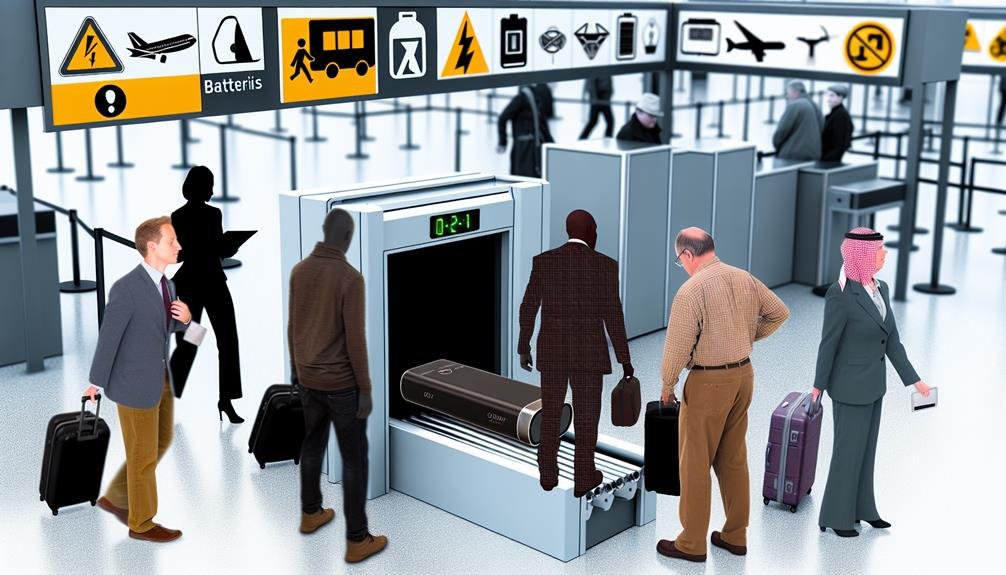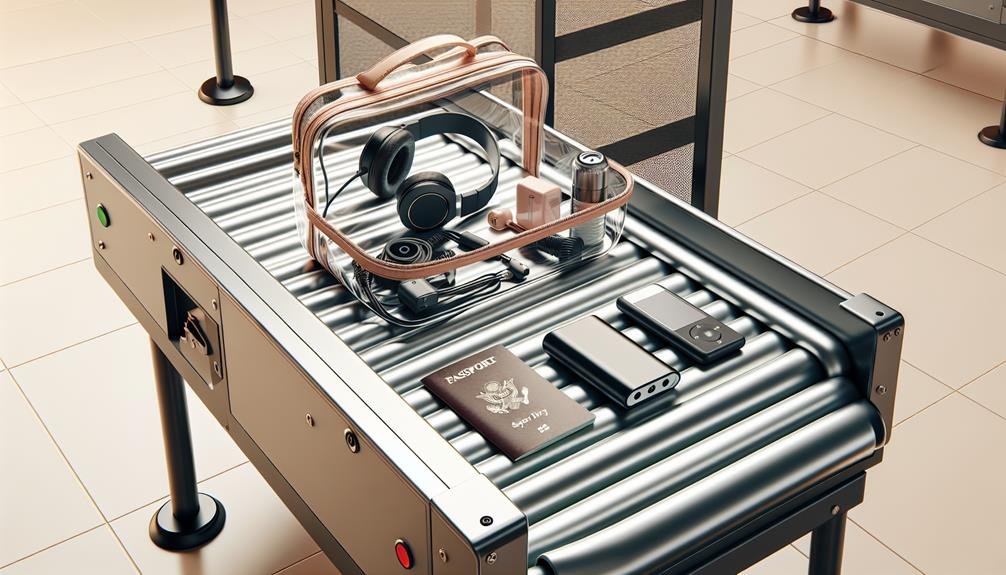Yes, you can fly with a power bank, but you need to follow specific regulations. TSA permits power banks up to 100 Wh in carry-on luggage without special permission. For power banks between 100 and 160 Wh, you'll need airline approval. Over 160 Wh are not allowed at all. Most airlines don't permit them in checked baggage due to fire risks. Always check the watt-hour capacity and follow airline-specific policies. Keeping it in your carry-on allows for easy monitoring and guarantees safety. If you're looking to minimize hassle and ensure smooth travel, there's more useful information to discover.
TSA Regulations

Curious about what the TSA regulations say about flying with a power bank? When you're preparing for air travel, especially international travel, it's essential to understand the rules governing power banks. The TSA (Transportation Security Administration) has clear guidelines to make sure everyone's safety.
First, power bank restrictions are primarily related to their capacity, measured in watt-hours (Wh). The TSA guidelines specify that power banks with a capacity of 100 Wh or less can be carried in your carry-on bag without any special permissions. If your power bank falls between 100 and 160 Wh, you're allowed to bring it, but you'll need airline approval. Power banks over 160 Wh are prohibited in both carry-on and checked baggage.
International travel adds another layer of complexity, as different countries might have additional regulations. However, most international airports follow similar guidelines to the TSA, so keeping your power bank within the 100 Wh limit is a good rule of thumb.
Airline Policies
When flying with a power bank, it's crucial to check the specific airline policies, as they can vary greatly from one carrier to another. Each airline has its own set of rules regarding power bank safety and legal restrictions, which are important for guaranteeing a safe flight. Some airlines might allow power banks in carry-on luggage only, while others could have more strict regulations.
Most airlines align with international portable battery guidelines, which typically restrict power banks from being placed in checked luggage due to potential fire hazards. Instead, you're generally required to carry them in your hand luggage. It's necessary to familiarize yourself with these rules to avoid any last-minute surprises at the airport.
Additionally, in-flight usage of power banks can also be subject to specific airline policies. Some carriers might permit you to use your power bank to charge devices during the flight, but always check with the flight attendants first. Unauthorized use could lead to complications or even flight delays.
Ultimately, adhering to the airline's guidelines not only ensures compliance with legal restrictions but also makes a significant contribution to overall flight safety. Always double-check with your carrier to stay informed about the latest policies and procedures.
Power Bank Capacity Limits

When flying with a power bank, you need to be aware of specific capacity limits set by airlines, typically measured in watt-hours (Wh). Understanding how to calculate watt-hours from milliamp-hours (mAh) and voltage is important to make sure your device complies with these regulations. Additionally, knowing the maximum size allowed can save you from potential hassles at security checks and boarding gates.
Airline Specific Regulations
Although regulations can vary, most airlines have strict guidelines regarding the maximum capacity for power banks that passengers can carry on board. Typically, power bank restrictions are in place to guarantee passenger safety and to prevent potential hazards. Most airlines allow power banks with a capacity of up to 100 watt-hours (Wh) without prior approval. If your power bank exceeds this limit but is under 160 Wh, you may need to seek special permission from the airline.
When it comes to power bank transportation, it's essential to understand these limits and adhere to them. Airlines generally prohibit power banks in checked luggage due to the fire risk they pose. Instead, you must carry them in your hand luggage. During security checks, be prepared to remove your power bank from your bag to be scanned separately. This is part of the safety measures designed to identify and manage potential threats.
Watt-Hour Calculation
Understanding how to calculate the watt-hour (Wh) capacity of your power bank is essential for guaranteeing compliance with airline regulations. Airlines often set limits on the battery storage capacity of power banks to secure passenger safety. To calculate the Wh of your power bank, you'll need to know its milliamp-hour (mAh) rating and voltage (V). The formula is simple: Wh = (mAh/1000) × V. For example, if your power bank has a capacity of 20,000 mAh and operates at 3.7 volts, the calculation would be (20,000/1000) × 3.7, resulting in 74 Wh.
Most airlines permit power banks with a capacity of up to 100 Wh without prior approval. If your power bank exceeds this limit but is still under 160 Wh, you might need special permission from the airline. Always check the specific guidelines of the airline you're flying with to avoid any last-minute hassles.
When selecting a power bank for travel, make sure it meets these capacity limits. This guarantees you can keep your charging devices powered without compromising safety. Properly calculating and adhering to these regulations keeps everyone onboard safe while allowing you to maintain the convenience of portable battery storage.
Power Bank Size
To confirm your power bank complies with airline safety regulations, you need to be aware of the specific capacity limits set by different airlines. Most airlines follow guidelines from aviation authorities, which generally permit power banks up to 100 watt-hours (Wh) in your carry-on luggage without prior approval. However, if your power bank falls between 100Wh and 160Wh, you'll likely need airline permission. Power banks exceeding 160Wh are usually prohibited.
In addition to capacity, consider your power bank's weight and dimensions. Airlines often have limits on the size and weight of carry-on items, and bulky or heavy power banks might be problematic. Assure your power bank is compact and light enough to fit within these restrictions. Typically, a power bank with a capacity of 20,000mAh or less will be within the safe range, but always check the watt-hour rating to be certain.
Furthermore, it's prudent to verify the specific regulations of your airline before flying. Some airlines may have more stringent rules or additional requirements. Understanding these limits will help you avoid any inconveniences at security checkpoints and guarantee a smooth travel experience.
Carry-On Vs. Checked Luggage
When flying with a power bank, it's important to know that most airlines only permit them in carry-on luggage due to safety regulations. This is because power banks contain lithium-ion batteries, which can pose a fire hazard if damaged or improperly stored. Airline restrictions are in place to mitigate these risks and guarantee everyone's safety onboard. By keeping your power bank in your carry-on, you can easily access it and monitor its condition throughout the flight.
From a travel convenience perspective, having your power bank in your carry-on is beneficial. You can charge your devices during the flight, ensuring they're ready to use once you land. However, it's essential to adhere to the airline's safety measures, such as confirming the power bank is within the allowed watt-hour limits and has its terminals protected to prevent short-circuiting.
Security concerns also play a role in this regulation. In the event of an emergency, cabin crew can quickly address issues related to power banks in the cabin, whereas accessing them in the cargo hold would be much more challenging. Consequently, following these guidelines not only aligns with airline policies but also guarantees a safer travel experience for everyone.
Tips for Traveling
When preparing for your trip, make sure you pack your power bank smartly and adhere to all airline regulations to avoid any hassles. Always keep your power bank in your carry-on luggage and know the capacity limits imposed by airlines. To optimize charging efficiency, use high-quality cables and keep your devices charged to avoid running out of power mid-flight.
Pack Smartly and Safely
Packing smartly and safely, especially with devices like power banks, guarantees a hassle-free travel experience and compliance with airline regulations. When preparing for your trip, prioritize power bank safety by ensuring your device meets the airline's battery capacity limits—typically under 100Wh. Always check the specifications, as airport security is stringent about these rules.
Include your power bank in your carry-on luggage rather than checked baggage. This not only assures easy access but also aligns with safety protocols. In case of an emergency, flight attendants can swiftly address any issues with your power bank if it's in the cabin, reducing potential hazards.
When considering travel essentials, opt for power banks with built-in safety features, such as overcharge and short-circuit protection. Store them in protective cases to prevent accidental activation and physical damage. Keeping your power bank and other electronics organized in a dedicated section of your bag can expedite the airport security process, as you'll be able to quickly present them when asked.
Lastly, avoid packing multiple high-capacity power banks. Stick to one or two that suffice for your needs, minimizing the risk of complications during your trip. Smart packing leads to a safer, more enjoyable travel experience.
Follow Airline Regulations
To guarantee a smooth journey, always adhere to airline regulations regarding power banks and battery-operated devices. Power bank safety is a top priority for airlines and ignoring their guidelines can lead to complications during your travel. Here are some essential tips to help you navigate the rules:
- Check Capacity Limits: Most airlines have restrictions on the watt-hour (Wh) rating of power banks. Typically, power banks under 100Wh are allowed, but always double-check with your airline.
- Carry-On Only: Power banks should never be placed in checked luggage. They must be carried in your hand luggage to comply with airport security protocols.
- Quantity Limits: You might be limited to carrying a specific number of power banks. Usually, you can carry up to two power banks with a capacity between 100Wh and 160Wh.
- Proper Packaging: Make sure your power banks are properly packed to prevent short circuits. Use protective covers or pouches to minimize risks.
- Declare If Necessary: Some airlines require you to declare power banks at the check-in counter. Being proactive can save you time and prevent any last-minute hassles.
Following these guidelines will not only keep you compliant but also guarantee the safety of all passengers on board.
Optimize Charging Efficiency
Maximize your charging efficiency while traveling by using a high-capacity power bank and prioritizing devices that require the most power. A reliable power bank is one of the key travel essentials you'll need to keep your devices running. Make sure to follow these charging tips to enhance battery safety and efficiency on your journey.
- Charge in Order of Importance: Prioritize charging your essential devices first, such as your smartphone and laptop, before moving on to less critical gadgets like e-readers or fitness trackers.
- Use Efficient Charging Cables: Always carry high-quality, efficient charging cables. Inferior cables can slow down the charging process and compromise battery safety.
- Monitor Battery Levels: Regularly check the battery levels of your portable chargers and devices to avoid overcharging or undercharging, which can deteriorate battery life.
Here's a quick reference table to help you prioritize:
| Device | Priority Level |
|---|---|
| Smartphone | High |
| Laptop | High |
| Tablet | Medium |
International Flights
When flying internationally, it's essential to understand the varying regulations regarding power banks to guarantee a smooth travel experience. Different countries and airlines have specific rules about carrying power banks in your luggage. To help you navigate these rules, let's break down some key points.
First, always check the airline's guidelines for carrying power banks. Most airlines allow power banks in carry-on luggage but not in checked baggage. The capacity limit usually hovers around 100Wh, but some airlines allow up to 160Wh with prior approval. It's vital to be aware of these limits to avoid any delays or confiscations at security checkpoints.
While you're on the flight, remember that many airlines provide in-flight entertainment and power sources to charge your devices. However, power sources might not always be reliable, making your power bank a valuable backup. Additionally, airports often have charging stations and various connectivity options, but these can be crowded or unavailable during peak times.
Here are some tips to ensure a seamless experience:
- Verify your power bank's watt-hour rating.
- Keep your power bank in your carry-on.
- Inform airline staff if your power bank exceeds the standard limit.
- Use manufacturer-approved power banks only.
- Familiarize yourself with both departure and arrival country regulations.
Frequently Asked Questions
Can I Use My Power Bank During the Flight?
Imagine your power bank as a lifeline in the sky. You can use it for in-flight charging, but be mindful of power bank capacity. Regulations impose restrictions, so check airline guidelines to guarantee safety and compliance.
Are There Specific Brands of Power Banks Recommended for Air Travel?
When selecting the top power bank brands for travel, consider Anker or RavPower. Guarantee your power bank capacity limits for flights don't exceed 100Wh. These brands meet safety standards, guaranteeing a hassle-free and secure flight experience.
What Should I Do if My Power Bank Overheats on a Plane?
If your power bank overheats on a plane, follow emergency power bank procedures. Turn it off, don't charge devices, and inform flight attendants immediately. Adhering to power bank safety and airplane etiquette guarantees everyone's safety.
How Do I Properly Store My Power Bank in My Carry-On Bag?
Did you know that improperly stored power banks cause 62% of in-flight battery fires? Follow power bank regulations by placing it in a protective case and organizing your carry-on to keep it easily accessible and cool.
Can I Charge Multiple Devices Simultaneously With My Power Bank While Traveling?
Yes, you can charge multiple devices simultaneously with your power bank while traveling. However, practice good charging etiquette and confirm that your devices are compatible to avoid any compatibility issues or safety hazards during your trip.



